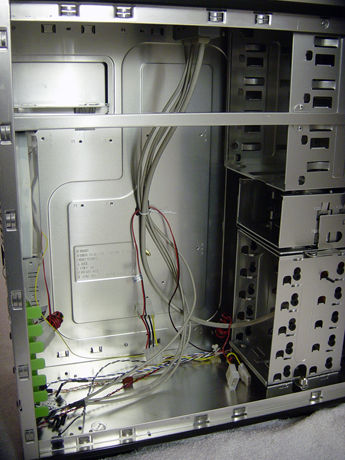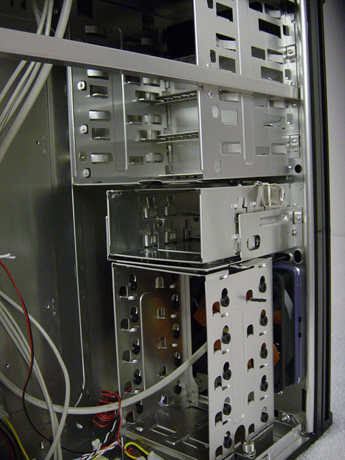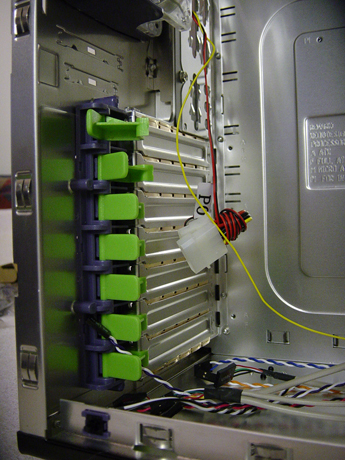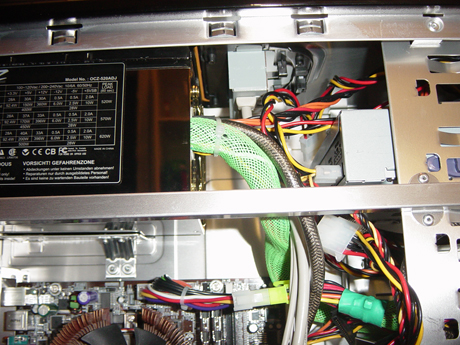Thermaltake Tsunami: A Complete Visual Overhaul
by Purav Sanghani on September 10, 2004 12:00 PM EST- Posted in
- Cases/Cooling/PSUs
Internal Design
After removing the right side panel, we took a closer look at the Tsunami's aluminum insides. Though the size of the case compares to that of the Cooler Master Centurion and the Enermax Sea Hawk, we were amazed at how much Thermaltake packed into the Tsunami.At the front of the case reside the drive bays. There are four 5-1/4" drive bays at the top. Thermaltake has carried on their drive rail idea to the Tsunami and has included enough to install the four 5-1/4" drives without any hassle. A tool-less design isn't fully implemented, but the most important areas do have devices to make installation much easier.
Below those bays are two 3-1/2" floppy bays and this is where things get interesting. This bay can be removed by pulling back on the spring clip and pulling the carriage back. We did see a flaw in this design in that while components like the motherboard are installed, the carriage cannot be easily removed from its place. These bays do not use drive rails and require screws to secure floppy drives.
A total of 5 HDD's can be mounted in the second removable drive carriage at the bottom of the case. The bays have rubber mounts to absorb any shock that could damage installed hard drives. Thermaltake has included thumbscrews to mount HDD's in place. This carriage is also easily removable, unlike the first one, by removing the thumbscrew which anchors the bay, pressing down on the release and pulling the carriage outwards to the left side of the case.
Moving on to the expansion slots, we see a new securing device for expansion cards. Instead of sliding clips, which Thermaltake has used in the past, we noticed that they implemented a new horizontally pivoting clip, which holds cards in place. They are just as effective, if not more, as the sliding clips.
Looking up to where the power supply is mounted, we noticed the lack of space needed to install an oversized unit, or any unit at all, successfully. The bundle of wiring from the auxiliary ports at the top of the case interfered and needed to be removed in order to slide the power supply in place. The cross bar that provides support to the chassis structure, since it is aluminum, was also a block in the road, but we figured there was nothing that the manufacturer could do to get rid of this. We installed our test bed motherboard in the Tsunami first, so our Zalman heatsink fan became a huge problem also. Instead of removing the heatsink, we decided it would be easier to remove the auxiliary pod. Our OCZ PowerStream just barely slid into place.














31 Comments
View All Comments
DonB - Friday, September 10, 2004 - link
Front panel needs a whackin' big ol' spider emblem, if you want it to look REALLY nice!themelon - Friday, September 10, 2004 - link
the harddrive cage on my 2 slk3700's is in an identicle position to the pictures in this review.JohnnyCNote - Friday, September 10, 2004 - link
No, just what happens when I don't look closely. I wish they had a way to delete messages on this thing....cobalt - Friday, September 10, 2004 - link
Hello WaveMaster #2. :)ciwell - Friday, September 10, 2004 - link
"Never mind, it was for a different case... "That was rich. :-D
JohnnyCNote - Friday, September 10, 2004 - link
Never mind, it was for a different case...JohnnyCNote - Friday, September 10, 2004 - link
Sorry for the blank posts...JohnnyCNote - Friday, September 10, 2004 - link
"With a price tag of around $100"Yeah, where? I clicked on the "AnandTech Deals" thing at the top of the page and saw nothing below $150....
JohnnyCNote - Friday, September 10, 2004 - link
JohnnyCNote - Friday, September 10, 2004 - link